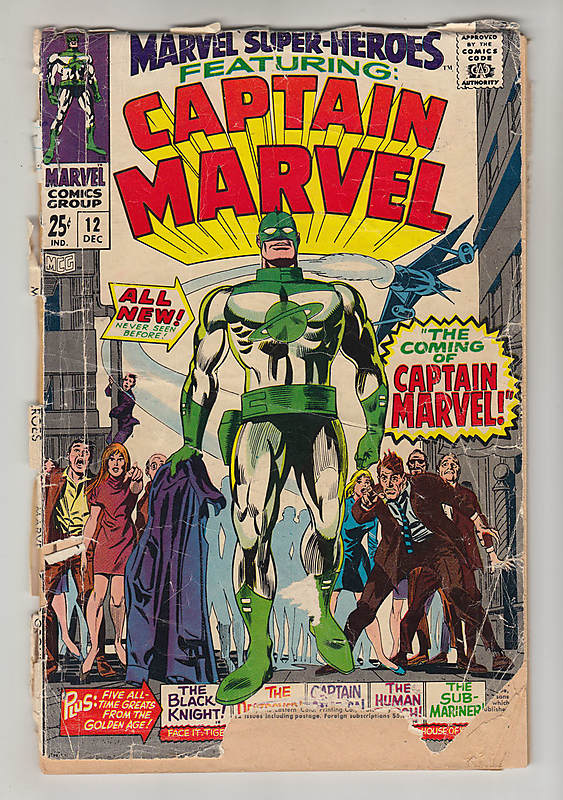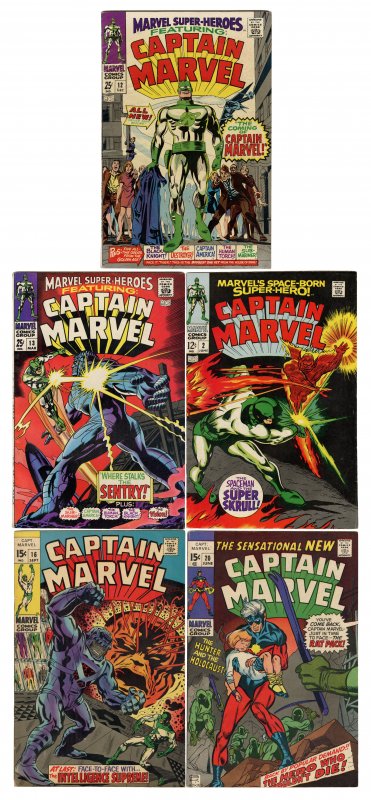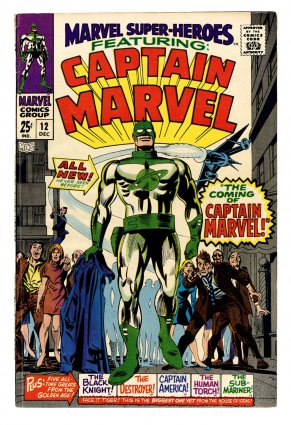MARVEL SUPER-HEROES (1967-82) #12
VG/F: 5.0

(Stock Image)

YES
Accepting Offers
--
Offers
PUBLISHER: Marvel
COMMENTS: Gene Colan cover/art; Origin/1st app. of Captain Marvel (Mar-Vell), 1st app. of Yon-Rogg and Una; COMIC BOOK IMPACT rating of 8 (CBI).
Read Description ▼
DESCRIPTION
Gene Colan cover/art; Origin/1st app. of Captain Marvel (Mar-Vell), 1st app. of Yon-Rogg and Una; COMIC BOOK IMPACT rating of 8 (CBI).Marvel Super-Heroes #12 introduces us the first Captain Marvel of Marvel comics after Fawcett comics ceased the publication of their popular hero by the same name due to a lawsuit by DC. To Marvel it was essential to own the trademark on the name because of the connection to their own company, thus began a long battle outside of the books to keep the name in-house. In this premiere we meet Dr Walter Lawson aka Mar-Vell, a Kree science officer who travels to Earth to spy on humans for his home planet, after growing affectionate for earthlings aids them in several occasions against the Kree. Seeing his actions as treasonous, Mar-Vell was exiled from his home where he would go on to be a solo hero taking part in numerous cosmic adventures while also teaming up with other heroes against the Kree Empire and the Mad Titan, Thanos. Ironically the character didn't really catch on with readers until a graphic novel was released that told the story of his death. The publication featured heroes and villains from all over the Marvel Universe paying their respects, with even Thanos stating that Mar-Vell was his greatest adversary. Over the years the mantle of Captain Marvel was passed on to many characters as Marvel fiercely tried to keep the trademarked name under their control. Currently and possibly the most notable character to bear the title is Carol Danvers, formerly Ms. Marvel, who made her cinematic debut in 2019's “Captain Marvel.” Though the original Captain Marvel initially failed to grasp readers, the character eventually developed a cult following and became a hero whose legacy would have lasting ramifications in comics and movies to this day. With the current cinematic universe ramping up to feature more stories based on the Mar-Vell legacy, comic book investors and collectors expect the value of this book to increase dramatically in the next few years.
Artists Information
Bill Everett was an American comic book writer-artist best known for creating Namor the Sub-Mariner, as well as co-creating Daredevil with writer Stan Lee for Marvel Comics. Everett fell into comics almost by accident in the industry's earliest days, creating the character Amazing-Man for Centaur Publications in 1939. That same year saw Everett contributing the first Sub-Mariner story for Marvel Mystery Comics #1, the very first book from Timely Comics (which would eventually become Marvel Comics). Sub-Mariner would prove to be one of Timely's earliest hits, and Everett would continue drawing Namor's adventures until 1949. In the '50s, Everett would continue working for what was now Atlas Comics on numerous titles, occasionally reviving Sub-Mariner. With the explosion of the Marvel Age in the '60s, Everett joined Stan Lee in co-creating and drawing the first issue of Daredevil. He also found regular work contributing to Tales to Astonish and Strange Tales. The Sub-Mariner would return again in Tales to Astonish #85, continuing there (and then in his own title) with sporadic contributions from Everett. Bill Everett died suddenly at the age of 55 in 1973.
Eugene Jules Colan was an American comic book artist best known for his work for Marvel Comics, where his signature titles include the superhero series Daredevil, the cult-hit satiric series Howard the Duck, and The Tomb of Dracula, considered one of comics' classic horror series. He co-created the Falcon, the first African-American superhero in mainstream comics, Carol Danvers, who would become Ms. Marvel and Captain Marvel, and the supernatural vampire hunter Blade.
Richard "Dick" Ayers was an American comic book artist and cartoonist best known for his work as one of the main inkers during the late-1950's and 1960's Silver Age of Comics, including some of the earliest issues of Marvel Comics' including Jack Kirby's The Fantastic Four. He is the signature penciler of Marvel's World War II comic Sgt. Fury and his Howling Commandos, drawing it for a 10-year run, and he co-created Magazine Enterprises' 1950s Western-horror character the Ghost Rider, a version of which he would draw for Marvel in the 1960s. His career would span 7 decades until his death in 2014.
Frank Giacoia (July 6, 1924 – February 4, 1988) was an American comics artist known primarily as an inker. He sometimes worked under the name Frank Ray, Giacoia made the rounds to almost every Golden Age publisher, notably working on Flash and Batman stories, he also worked at Timely during this period. In the Silver Age Frank worked on many Jack Kirby pages, particularly in Captain America, and he also notably inked the first appearance of the Punisher in AMS #129.
John Romita was one of the driving forces behind Marvel's Silver Age, first taking up the reins on Amazing Spider-Man following the departure of Steve Ditko with issue #38. Romita's long run on Spider-Man would include the introduction of classic characters such as Mary Jane Watson, the Kingpin and many others. He would be a major contributor to the entire Marvel line throughout the 1970s — including designing the look of The Punisher. Romita's influence has since been felt for decades, including the emergence of John Romita, Jr. as one of the industry's top illustrators.
Artists Information
Bill Everett was an American comic book writer-artist best known for creating Namor the Sub-Mariner, as well as co-creating Daredevil with writer Stan Lee for Marvel Comics. Everett fell into comics almost by accident in the industry's earliest days, creating the character Amazing-Man for Centaur Publications in 1939. That same year saw Everett contributing the first Sub-Mariner story for Marvel Mystery Comics #1, the very first book from Timely Comics (which would eventually become Marvel Comics). Sub-Mariner would prove to be one of Timely's earliest hits, and Everett would continue drawing Namor's adventures until 1949. In the '50s, Everett would continue working for what was now Atlas Comics on numerous titles, occasionally reviving Sub-Mariner. With the explosion of the Marvel Age in the '60s, Everett joined Stan Lee in co-creating and drawing the first issue of Daredevil. He also found regular work contributing to Tales to Astonish and Strange Tales. The Sub-Mariner would return again in Tales to Astonish #85, continuing there (and then in his own title) with sporadic contributions from Everett. Bill Everett died suddenly at the age of 55 in 1973.
Eugene Jules Colan was an American comic book artist best known for his work for Marvel Comics, where his signature titles include the superhero series Daredevil, the cult-hit satiric series Howard the Duck, and The Tomb of Dracula, considered one of comics' classic horror series. He co-created the Falcon, the first African-American superhero in mainstream comics, Carol Danvers, who would become Ms. Marvel and Captain Marvel, and the supernatural vampire hunter Blade.
Richard "Dick" Ayers was an American comic book artist and cartoonist best known for his work as one of the main inkers during the late-1950's and 1960's Silver Age of Comics, including some of the earliest issues of Marvel Comics' including Jack Kirby's The Fantastic Four. He is the signature penciler of Marvel's World War II comic Sgt. Fury and his Howling Commandos, drawing it for a 10-year run, and he co-created Magazine Enterprises' 1950s Western-horror character the Ghost Rider, a version of which he would draw for Marvel in the 1960s. His career would span 7 decades until his death in 2014.
Frank Giacoia (July 6, 1924 – February 4, 1988) was an American comics artist known primarily as an inker. He sometimes worked under the name Frank Ray, Giacoia made the rounds to almost every Golden Age publisher, notably working on Flash and Batman stories, he also worked at Timely during this period. In the Silver Age Frank worked on many Jack Kirby pages, particularly in Captain America, and he also notably inked the first appearance of the Punisher in AMS #129.
John Romita was one of the driving forces behind Marvel's Silver Age, first taking up the reins on Amazing Spider-Man following the departure of Steve Ditko with issue #38. Romita's long run on Spider-Man would include the introduction of classic characters such as Mary Jane Watson, the Kingpin and many others. He would be a major contributor to the entire Marvel line throughout the 1970s — including designing the look of The Punisher. Romita's influence has since been felt for decades, including the emergence of John Romita, Jr. as one of the industry's top illustrators.


MARVEL SUPER-HEROES (1967-82) #12
Marvel PR: 0.5
Gene Colan cover/art; Origin/1st app. of Captain Marvel (Mar-Vell), 1st app. of Yon-Rogg and Una; COMIC BOOK IMPACT rating of 8 (CBI).
Gene Colan cover/art; Origin/1st app. of Captain Marvel (Mar-Vell), 1st app. of Yon-Rogg and Una; COMIC BOOK IMPACT rating of 8 (CBI).


MARVEL SUPER-HEROES (1967-82) #12 Comic Book Group Lot
Marvel FN: 6.0
A 15% BUYER'S PREMIUM WILL BE ADDED TO THIS ITEM AT CONCLUSION OF THE AUCTION
group lot of 5 Captain Marvel comics; Marvel Super-Heroes #12-13, Captain Marvel #2, 16, 20; includes 1st appearances Captain Marvel, Carol Danvers, new Captain Marvel costume; Avg. Grade 6.0; Total Est. Book Value $475
group lot of 5 Captain Marvel comics; Marvel Super-Heroes #12-13, Captain Marvel #2, 16, 20; includes 1st appearances Captain Marvel, Carol Danvers, new Captain Marvel costume; Avg. Grade 6.0; Total Est. Book Value $475
A 15% BUYER'S PREMIUM WILL BE ADDED TO THIS ITEM AT CONCLUSION OF THE AUCTION
group lot of 5 Captain Marvel comics; Marvel Super-Heroes #12-13, Captain Marvel #2, 16, 20; includes 1st appearances Captain Marvel, Carol Danvers, new Captain Marvel costume; Avg. Grade 6.0; Total Est. Book Value $475
group lot of 5 Captain Marvel comics; Marvel Super-Heroes #12-13, Captain Marvel #2, 16, 20; includes 1st appearances Captain Marvel, Carol Danvers, new Captain Marvel costume; Avg. Grade 6.0; Total Est. Book Value $475
Starting Bid: $1
(No Reserve)
(No Reserve)
Auction Starts In




Gene Colan cover/art; Origin/1st app. of Captain Marvel (Mar-Vell), 1st app. of Yon-Rogg and Una; COMIC BOOK IMPACT rating of 8 (CBI).
Gene Colan cover/art; Origin/1st app. of Captain Marvel (Mar-Vell), 1st app. of Yon-Rogg and Una; COMIC BOOK IMPACT rating of 8 (CBI).